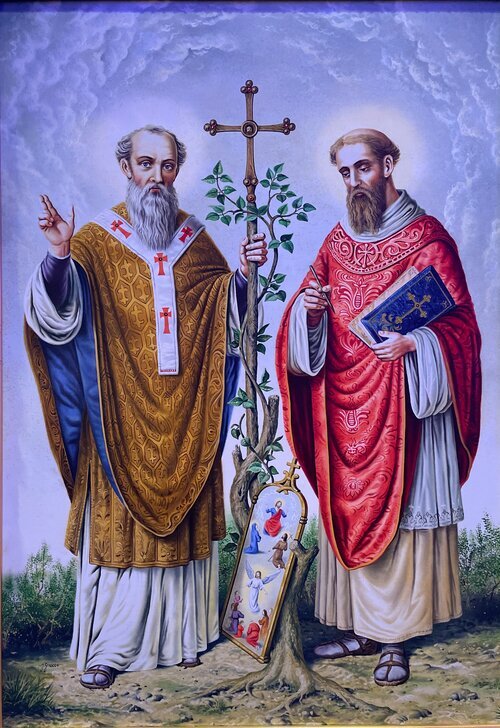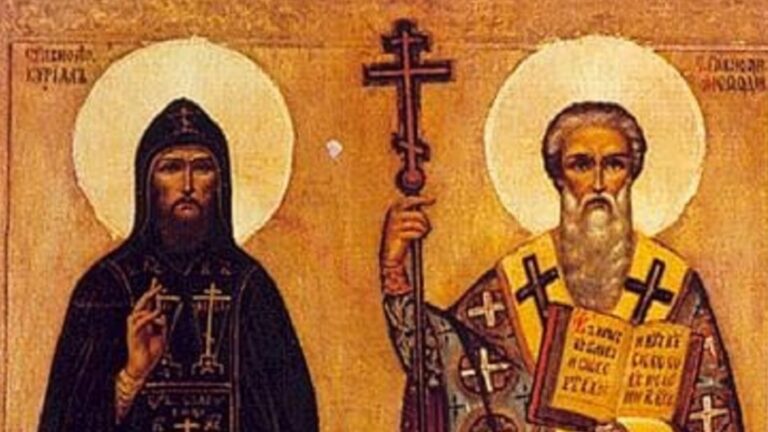On February 14th, the day of two saints who were brothers and born in the 9th century is celebrated. As a result of their work, Saint Cyril and Saint Methodius are venerated for their educational and cultural mission among the Slavic people.
In the name of the Father, and of the Son, and of the Holy Spirit. Amen
Our help is in the name of the Lord,
who made heaven and earth.
O Lord hear my prayers,
and let my cry come unto you
Examination of conscience…
Lord have mercy…
Christ have mercy…
Lord have mercy…
 OPENING PRAYER
OPENING PRAYERGod the Father of kindness, enlightened by the missionary ideal of Saint Cyril and Methodius, may we too be clothed with the grace to bring the message of love that flows from the gospel to the most abandoned men and women of our time, bearing witnesses to the life of the gospel in the imitation of saint Cyril and Methodius. through their humble prayers, may we come to enjoy the graces of (name your intentions). Through our Lord Jesus Christ your Son, who lives and reigns with you and the Holy Spirit, God forever and ever. Amen.
Saint Cyril and Saint Methodius, pray for us.
MEDITATION: THE STORY OF THE TWO BROTHERS – CYRIL AND METHODIUS
(Part 3 – LEGACIES)

The Byzantine mission of saint brothers Cyril and Methodius had a major impact on the spiritual history of Great Moravia. In the centuries that followed, their works paved the way for the political and historical development of the Slavic nations, mainly in South-East and East Europe.
The mission, which reached Great Moravia in 863, had several dimensions. The most important were evangelism and the cultural and civilizational dimensions. Translations of the Gospel and liturgical texts into Old Church Slavonic intensified the religious life of our ancestors and laid the foundations of literature and culture for almost the entire Slavic world. From this point of view, research should be focused on the role and reflection of this historical and cultural heritage in the ecclesiastical and spiritual, national, and cultural life of the Slavic nations. The Cyrillo-Methodian idea manifests itself in the history of the Slavic world as a complex but solid foundation, capable of renewing the sleeping or inhibited energy and values in the areas of
faith, culture, literature, arts, education, upbringing, as well as national consciousness.
Most of the works on Cyril and Methodius are in Slavic or Russian. There are several helpful books in English, however. Francis Dvornik, The Slavs: Their Early History and Civilization (1956), describes the brothers’ influence on the life and language of the people among whom they worked. Zdenek Radslav Dittrich, Christianity in Great-Moravia (1962), is a scholarly study of the history of the churches they helped found, and Matthew Spinka, A History of Christianity in the Balkans (1968), places their missionary results in the context of the history of eastern Europe.
(My thoughts…)
Point for reflection:
- Cyril and Methodius tried to understand the people and their culture. Reflect on the importance of loving and accepting people as they are.
 CONCLUDING PRAYER
CONCLUDING PRAYER
Through the intercession of saints Cyril and Methodius, may the Lord bless + us, protect us from all evil and bring us to everlasting life. Amen.
👏🏼👏🏼 Great job praying Day 3! May the good Lord hear our humble prayers. Amen.👏🏼👏🏼
HAPPY FEAST DAY OF SAINTS CYRIL AND METHODIUS!!!
Shalom!
Compiled by Fr. Chinaka Justin Mbaeri, OSJ
Paroquia Nossa Senhora da Immaculada Conceição, Paulo Ramos, Maranhão, Brazil
nozickcjoe@gmail.com / fadacjay@gmail.com
___________________________________
PS: Have you prayed your Rosary today?



Happy feast day
As Cyril and Methodious, pray for us
Ss Cyril and Methodius, pray for us
I pray God that all said I tensions and unsaid my be heard and answered through Christ our Lord amen.
From the life of Sts Cyril and Methodius who tried to understand the people and their culture., may we learn to understand ourselves.
Saints brothers Cyril and Methodius, Pray for us Amen. Happy feast of the two great Saints to all of us and may the Lord help us to understand each other in spite of our languages and diversity.
St Cyril and Methodius pray for us that we may find paths of peace in our families and our Country Nigeria. Amen
May the Lord give us the grace to accept people as they are & Grant our prayers. Amen
Amen
May saint Cyril and methodius intercede for me and my entire household through Christ our Lord Amen.
Saint Cyril and methodius,
Pray for us.
Happy feast day to SS Cyril and Methodius to all those who bear the names.
St Cyril and Methodious, pray for us
Happy feast day…
Amen
Amen
Saints Cyril and Methodius pray for us.
St Cyril and St Methodius, pray for us
God in His infinite mercy through the intercession of St. Cyril and Methodius have mercy on our country Nigeria, in this time of elections.
Oh great sts. Cyril and Methodius, help me to accept others the way they are and love Christ more.
Happy feast day of saint Cyril and Methodius
I pray the good lord perfects my health in the Mighty Name of Our Lord Jesus ChristAmen
Happy feast day to us all.
May St Cyril and Methodius continue to intercede for us all through Christ our Lord
St Cyril and St Methodius, please continue to intercede for our country Nigeria and through your prayers, may God send consolation to grieving families in Turkey and other victims of natural disasters
Happy feast day of St Cyril and Methodius.
May we learn to understand each other.
St Cyril and Methodius pray for us
Thank You Saints Cyril and Methodius for your intercession, Amen!
Thank you Jesus for the successful completion of the 3 days Novena to Saints Cyril and Methodius. I pray for their intercession for my family.
St. Cyril and St. Methodius!
Pray for Us.
Amen
Amen
Sts Cyril and Methodius, pray for us amen
Amen.
Thank you Padre for this beautiful prayer, God bless you abundantly.
Happy Feast day
St Cyril and St Mathadius pray for us, Amen
Thank you Padre
Amen
Thank You Jesus for always
Amen
Saints Cyril and Methodius, please pray for my intentions. Amen
Amen
Amen
Saint Cyril and Saint Methodius pray for us and answer our petitions. Amen.
Amen
St. Cyril and Methodius pray for us always. Amen
St. Cyril and Methodius pls help me to understand the importance of loving and understanding people as they are.
May the Lord bless us all richly and answer our prayers through the intercession of Saints Cyril and Methodius. And may HIS perfect will be done in our lives in JESUS’ NAME, amen.
Amen
Saint Cyril and Saint Methodius, pray for us Amen
Saint Cyril and Saint Methodius, pray for us!
St. Cyril and Methodius pray for us, obtain for the grace of being good imitators of your humble approach to people around you.
May our lives and living today reflect the lessons learned from the examples of Sts. Cyril and Methodius.
Happy feast day of Saint Cyril ans Methodius!
St Cyril and Methodius intercede for us.
Thank you, Jesus, for the gift of these saints.